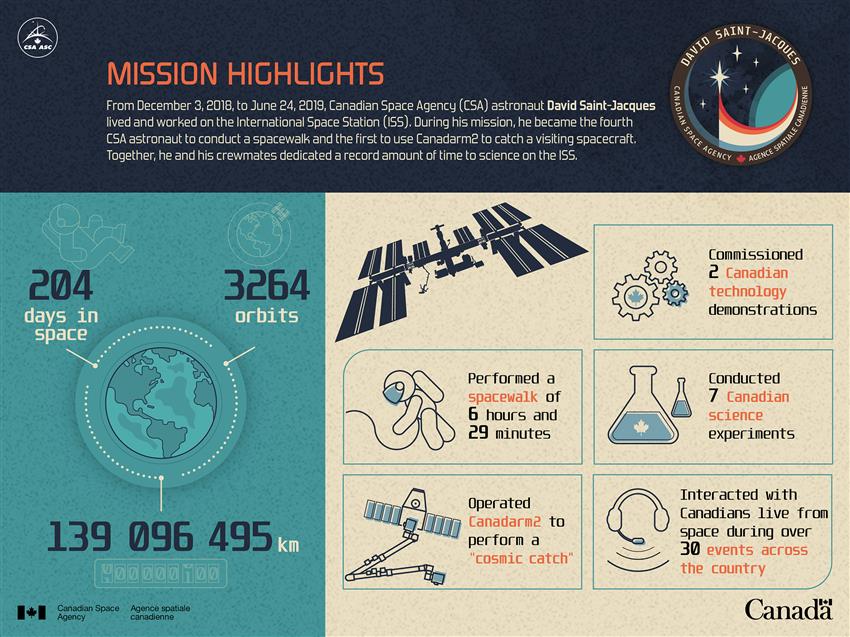Mission highlights
On , at 6:31 a.m. ET, Canadian Space Agency (CSA) astronaut David Saint-Jacques flew to the International Space Station (ISS). The successful landing on , marks the end of the longest Canadian mission to date (204 days).
During his time in space, David conducted Canadian and international science experiments and technology demonstrations. He supported critical operations and maintenance activities, including robotics and spacewalks. Like many other astronauts, he shared his experience through taking pictures and videos. From space, he also connected with young people across Canada, encouraging them to appreciate the beauty and fragility of our planet, and sparking their interest in science, technology, engineering and mathematics.
From to
- 204 days in space; 3,264 orbits around Earth; 139,096,495 kilometres travelled.
- As the Soyuz co-pilot, David assisted the commander of the spacecraft during their journey to and from the ISS, ready to take over completely should something have prevented the commander from performing his functions.
- David became the fourth CSA astronaut to complete a spacewalk on . He worked outside the Station for six and a half hours with NASA astronaut Anne McClain to complete a series of tasks.
- On , David operated Canadarm2, to capture a Dragon cargo vehicle. It was the first time a CSA astronaut performed a "cosmic catch." He also assisted robotics operations for the release of Northrop Grumman's Cygnus spacecraft on , and the capture of Northrop Grumman's Cygnus spacecraft on .
- David and his crewmates monitored the arrival and docking of the SpaceX's Crew Dragon, on its test flight, Demo-1.
- David participated in various science activities including 9 Canadian health science activities. (7 experiments and 2 technology demonstrations)
- Vascular Echo examines how and why some astronauts experience arterial stiffening in space. It builds on the Vascular experiment and will help find ways of slowing vascular aging.
- MARROW aims to establish if microgravity causes fat accumulation in the bone marrow and impacts the production, function and destruction of red and white blood cells.
- TBone studies the effects of weightlessness on bone quality, as bones age at an accelerated rate in space. Advanced 3D imaging technology measures bone density, but also bone structure and strength.
- Wayfinding aims to discover how astronauts get their bearings and find their way around by looking at their brains while they perform spatial orientation tasks.
- At Home in Space is Canada's first psychosocial experiment on board the ISS. It examines how astronauts from all over the world adapt to living together in space during long-duration missions.
- Vection uses a virtual reality system to examine how microgravity affects astronauts' perception of their motion.
- Radi-N2 measures the neutron radiation levels on the Space Station and monitors the dose an astronaut absorbs during space flight.
- Bio-Monitor (technology demonstration), which includes a smart shirt, will monitor and record astronauts' vital signs.
- Bio-Analyzer (technology demonstration) will perform near-real-time analysis of blood, urine, or saliva and provide data for research purposes.
- Various maintenance activities were accomplished, both inside and outside the ISS, on the Combustion Integrated Rack, the toilet, the Oxygen Generation System, the spacesuits and a CO2 scrubbing system.
Public outreach
- David took part in 25 events with Canadians live from space, including an appearance during the official announcement of Canada's participation in the next chapter of Moon exploration.
- He also spoke with students from Canada and around the world through 20 amateur radio connections (Amateur Radio on the International Space Station program). Nine in Canada and eleven international.
- A series of outreach activities were organized by the CSA and partners, including educational initiatives, contests, exhibitions and digital activities (game and e-book).
- David also participated in the ISS Experience, in which astronauts use a new 360° camera to document daily life aboard the Station for a virtual reality film.

Text version - on the graphic about David Saint-Jacques' Mission Highlights
David Saint-Jacques' Mission Highlights (Credit: Canadian Space Agency)